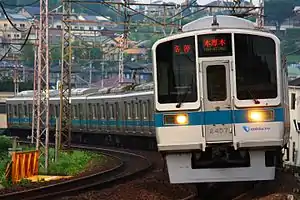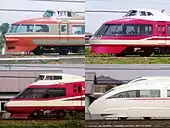Odakyu 2000 series
The Odakyu 2000 series (小田急2000形, Odakyū 2000-gata) is a commuter electric multiple unit (EMU) train that the private railway operator Odakyu Electric Railway has operated in the Tokyo area of Japan since March 1995.[1]
| Odakyu 2000 series | |
|---|---|
 An Odakyu 2000 series (July 2014) | |
| In service | 4 March 1995 – Present |
| Manufacturer | Nippon Sharyo (set #1,5,8) Kawasaki Heavy Industries (set #2,6,9) Tokyu Car Corporation (set #3,4,7) |
| Constructed | 1994 – 2001 |
| Number built | 72 vehicles (9 sets) |
| Number in service | 72 vehicles (9 sets) |
| Formation | 8 cars per trainset |
| Fleet numbers | 2051 – 2059 |
| Capacity | 1,240 (146 in leading car, 158 in intermediate car) |
| Operator(s) | Odakyu Electric Railway |
| Depot(s) | Ebina |
| Line(s) served | Odakyū Odawara Line, Tama Line |
| Specifications | |
| Car body construction | Stainless steel |
| Car length | 20,150 mm (leading car) 20,000 mm (intermediate car) |
| Width | 2,860 mm |
| Height | 4,145 mm (pantograph car) 4,060 mm (normal car) |
| Doors | 4 pairs per side |
| Maximum speed | 100 km/h (service) 120 km/h (design) |
| Weight | 256,6 t |
| Traction system | Mitsubishi-made 3-level VVVF (IGBT switching device) |
| Traction motors | Three-phase squirrel-cage induction motor (Mitsubishi) |
| Power output | 2,800 kW (175 kW x16) |
| Acceleration | 3.3 km/h/s (2.7 km/h/s before the 1998 timetable revision) |
| Deceleration | 4.0 km/h/s (service) 4.7 km/h/s (emergency) |
| Electric system(s) | 1,500 V DC overhead line |
| Current collection method | Pantograph |
| Bogies | Sumitomo Metal Industries SS143 (motored car) SS043 (trailer car) |
| Braking system(s) | Electronically controlled pneumatic brakes, electro-pneumatic command brakes, regenerative braking |
| Safety system(s) | OM-ATS, D-ATS-P |
| Coupling system | Shibata coupler |
| Track gauge | 1,067 mm (3 ft 6 in) |
Nine 8-car sets in total were manufactured between 1995 and 2001 in three batches. The design was based on the earlier 1000 series sets, with some of the passenger doors increased from 1,300 to 1,600 mm (4 ft 3 in to 5 ft 3 in) wide to help reduce station dwell times.[2]
Formation
As of 1 April 2015, the fleet consisted of nine 8-car sets, 2051 to 2059, formed as follows with four motored (M) cars and four unpowered trailer (T) cars. Car 8 is at the Shinjuku end.[3]
| Car No. | 1 | 2 | 3 | 4 | 5 | 6 | 7 | 8 |
|---|---|---|---|---|---|---|---|---|
| Designation | Tc2 | M5 | M4 | T2 | T1 | M2 | M1 | Tc1 |
| Numbering | 2450 | 2400 | 2300 | 2250 | 2150 | 2100 | 2000 | 2050 |
History
The trains were delivered between January 1995 and April 2001, with the first trains entering revenue service on 8 March 1995.[2] These sets are primarily used for Local services.
Build details
The build histories for the fleet are as follows.[2]
| Batch | Set No. | Delivery date |
|---|---|---|
| 1 | 2051 | January 1995 |
| 2052 | March 1995 | |
| 2 | 2053 | June 1998 |
| 3 | 2054 | October 2000 - April 2001 |
| 2055 | ||
| 2056 | ||
| 2057 | ||
| 2058 | ||
| 2059 |
In popular culture
The Odakyu 2000 series is featured as a player-driveable train in the Microsoft Train Simulator computer game.
References
- 私鉄車両年鑑2012 [Japan Private Railways Annual 2012]. Tokyo, Japan: Ikaros Publications Ltd. February 2012. p. 166. ISBN 978-4-86320-549-9.
- 2007小田急通勤車両オールガイド [2007 Odakyu commuter rolling stock complete guide]. Tetsudō Daiya Jōhō Magazine (in Japanese). Vol. 36 no. 278. Japan: Kōtsū Shimbun. June 2007. pp. 21–23.
- 私鉄車両編成表 2015 [Private Railway Rolling Stock Formations - 2015] (in Japanese). Japan: Kotsu Shimbunsha. 23 July 2015. p. 52. ISBN 978-4-330-58415-7.
External links
| Wikimedia Commons has media related to Odakyu 2000 series. |
- Nippon Sharyo information page
- Tokyu Car information page at the Wayback Machine (archived 20 July 2011)
